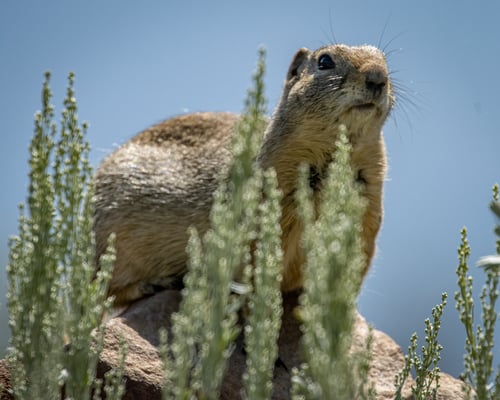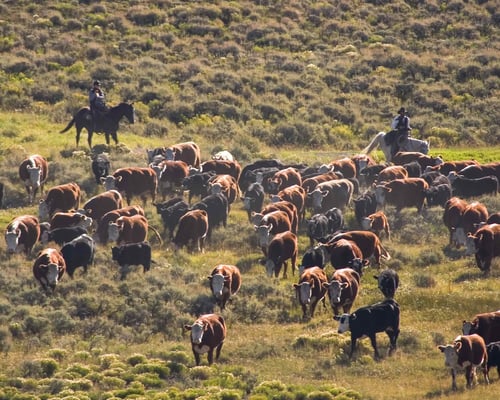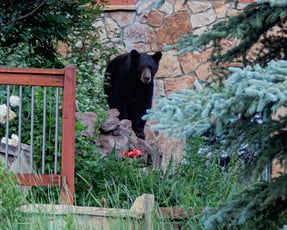Text by Jacci McKenna
All photos by Rick Spitzer, except as noted.
For the Eagle County Wildlife Roundtable
Be the Change, Save a Life
Have you ever wondered, "how can I make a difference for wildlife?" There are so many factors at play in our world, it sometimes feels overwhelming. A recent community survey revealed Eagle County residents value wildlife and want to protect them and their habitat which is a great start!
There are many ways to make a difference: give wildlife a brake; just say no to poisons, pesticides, lead ammunition/tackle and barbed wire fences; teach the next generation; be bear aware; go electric; keep pets leashed and get involved.
Ground squirrels are often poisoned on golf courses and in parks. The dead rodents may be consumed by predators and scavengers. The poison may also kill them.
Ecosystems are comprised of numerous species and each one, no matter how small, plays an important role. We are all interconnected and our ability to thrive depends on each member of the ecosystem being able to thrive. Our actions have a profound effect. I ride my bike up Brush Creek Road regularly and if I’m fortunate to have a ride where no animals are dead on the road, I consider that a good day. You would be amazed at the number of animals that get hit by traffic, from deer and elk to herons and owls to chipmunks and squirrels to weasels, rabbits and snakes. Each one likely has a family whose life is forever changed when they don’t come home. Be present, give wildlife a brake, save a life.
Healthy ecosystems are vibrant, filled with a cacophony of music. I’ll never forget waking up one morning realizing the squirrels on the golf course had been poisoned, the silence was deafening. Poisons used to control ground squirrels don’t stop with the squirrels. Hawks, coyotes and foxes are poisoned too when they eat those squirrels. Poisons come in many forms. If you ever saw an eagle suffering from lead poisoning because he ate from a carcass killed with lead ammunition, it would break your heart Nearly Half of US Bald Eagles Suffer Lead Poisoning.
That’s why it’s also critical that hunters and anglers don’t use lead ammunition/tackle. Every action has a reaction.
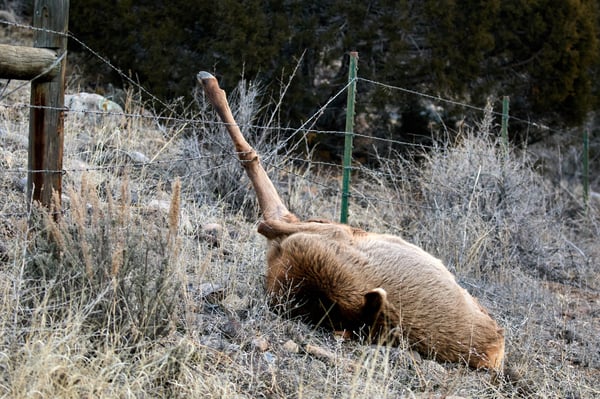
Deer and elk will occasionally not clear a fence with one hind leg getting wrapped up in the wire. (Photo by Ken Pollock)
Fences are deadly for wildlife, especially barbed wire. Imagine you are an elk, you’ve just had a baby and he is a few weeks old. You need to head to higher ground to protect your calf from predators. The problem is there are multiple barbed wire fences and a busy road to cross. You and other mothers attempt to cross the fence, some calves try to get under it, others try to get over and some are too afraid to even try. You pace back and forth calling to your calf, he attempts to jump over the fence only to have his stomach sliced open by barbed wire. A life gone in an instant and for what?
We may never know how many elk, deer and many other species are killed by barbed wire each year. There are alternatives, BLM has implemented a virtual fencing program that helps livestock owners manage herds effectively while reducing adverse impacts to wildlife, Virtual fencing on BLM grazing lands is restoring rangeland grasses.
Thank you to BLM and livestock owners participating in this program! Barbed wire can be replaced with wildlife friendly fencing. Either option saves lives.
I remember when I was a little girl, my mom picked up a daddy long legs spider from the bathtub to put it outside and she said to me, “spiders are our friends, they eat the flies.” It was a lesson at an early age about appreciating every creature and the role they play in the ecosystem. She’s no longer here in person, yet her lesson remains.
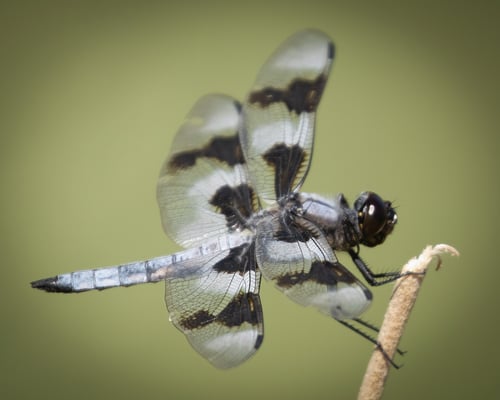
Fertilizers and pesticides wash off lawns and farm fields and often have impacts on riparian areas and the insects, like this eight-spotted skimmer dragonfly.
It’s back to school season, I enjoy watching parents ride bikes with their kids to school. What a great example they’re setting! Perhaps it’s also a time to take stock of wildlife along the way. I recently observed a dad showing his daughter how to pick up a dragonfly that was drowning “cup your hands underneath it so you don’t hurt it,” he said. She was proud to rescue the dragonfly and put it on shore so it could live another day. Talk with your kids about wildlife, how their actions can save a life.
When you’re on a hike and you see trash, do you pick it up? If it was your home, wouldn’t you want it kept clean? It’s no different for wildlife.
How about at home? Some of the kids’ chores might include taking out the trash and mowing the grass. Teach them to be bear aware, don’t overfill containers and take out trash only the morning of pickup. Get a bear resistant container and be sure it’s properly latched. A reminder from Town of Vail and CPW says it well, “Bear in mind, safe containers save wildlife. Unsecured trash can have fatal consequences for bears, 100 are euthanized in Colorado each year!”
Electric mowers and lawn tools reduce our carbon footprint helping to ensure a livable community for all of us. Our planet is warming, species like pika require cooler temperatures to survive Pikas Disappearing from Parts of the West Due to Climate Change.
Electric appliances and heat pumps that replace your gas furnace also reduce fossil fuel use; incentives are available to offset costs.

Spiders feed on insects. Insects may consume insecticides which may concentrate in the spider and kill it.
Speaking of lawns, pesticides are bad news for wildlife as referenced in Rachel Carson’s 1962 book “Silent Spring”. They are especially devastating for pollinators like bees and birds. Pesticides don’t just stay on the surface where they are applied – pollinators, birds, and other wildlife ingest them and they also seep into groundwater and rivers impacting invertebrates and fish. It’s all connected. Don’t use pesticides, use environmentally friendly solutions and only spot treat if necessary. Encourage your HOA to do the same.
Dogs and cats are our furry family members and we want them to be happy. It’s in their nature to explore and give chase when they see something move. I’ve seen them kill squirrels, birds, and other wildlife. As a responsible parent, it’s up to us to ensure all wildlife is protected, keep pets leashed.
What does “get involved” look like?
• Volunteer! It was beyond gratifying to remove barbed wire fence in Eagle County Open Space, it made a tangible difference. Become a Wildlife Trail Ambassador with VVMTA or Wilderness Ranger with ESWA to reinforce the importance of trail closures, keeping pets leashed and leave no trace principles.
• Be aware of proposed development in your community. Is it in critical wildlife habitat? Speak up, let leaders know you want to protect wildlife habitat and migration corridors. It’s essential to their survival.
The BLM has implemented a virtual fencing program that helps livestock owners manage herds effectively while reducing fencing and the adverse impacts they have on wildlife.
How can we make a difference for wildlife? Let me count the ways: give wildlife a brake; just say no to poisons, pesticides, lead ammunition/tackle and barbed wire fences; teach the next generation; be bear aware; go electric; keep pets leashed and get involved.
Chief Seattle was prophetic back in the 1800’s when he said, “If all the beasts were gone, men would die from a great loneliness of spirit, for whatever happens to the beasts happens to the man.” It’s up to each of us to make a difference, save a life. Who knows, the life we save may be our own.
Jacci McKenna
An environmentalist and wildlife advocate. Community Representative on the Education Committee of the Eagle County Community Wildlife Roundtable.
======================================
The Eagle County Community Wildlife Roundtable is a collaborative partnership with the White River National Forest, Colorado Parks and Wildlife, Bureau of Land Management, local government entities, community members, and citizen scientists. The purpose of the Eagle County Community Wildlife Roundtable is to gather a group of diverse stakeholders in the valley to understand and address issues facing wildlife populations. Together we will identify a shared vision and realistic actions that the community can rally around to support wildlife. We want to leverage diverse values, creativity, and resources to move toward positive action.
======================================


